You have a new option in voting… one booth on the left and another on the right. Your pick.
Marianna Popiełuszko, mother of a blessed died
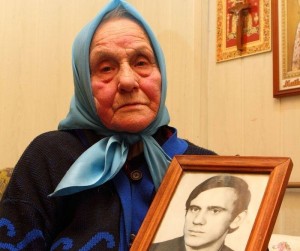 MARIANNA POPIEŁUSZKO, mother of Blessed Jerzy Popiełuszko, priest and martyr, DIED TODAY in the City Hospital in Białystok in Poland at the age of 93.
MARIANNA POPIEŁUSZKO, mother of Blessed Jerzy Popiełuszko, priest and martyr, DIED TODAY in the City Hospital in Białystok in Poland at the age of 93.
The funeral will take place on Saturday, 23 November 2013 in Suchowola.
Requiem aeternam dona ei, Domine, et lux perpetua luceat ei. Requiescat in pace. Amen.
Forming ‘the intelligence of the heart’
Jean-Louis Cardinal Tauran, president of the Pontifical Council for Interreligious Dialogue, spoke Monday (November 18) at the opening general assembly of the two-day Global Forum of the King Abdullah Bin Abdulaziz International Centre for Interreligious and intercultural Dialogue, Vienna, Austria.
The senior cardinal deacon Tauran used an insightful term that needs to developed, ‘intelligence of the heart,’ which he explains that “inspires us to respect what God is accomplishing in every human being” during the opening session of an inter-religious forum in Vienna, Austria, on Monday morning.
The difficulty raised with inter-religious dialogue with Muslims is the concept of the other person; Islam does not hold that people are made in the image and likeness of God. Catholics and Jews do and do so as fundamental to all else. And there is good reason to ask why we spend so much time and money on inter-religious dialogue when there is no identifiable goal to the work done. It seems doubtful that serious Muslims and serious Christians have one goal: conversion to the Truth: Christians ought to convert Muslims and Muslims convert Christians. Once admitted, then we can have a fruitful dialogue. But that will never happen. Nevertheless, what Cardinal Tauran states is serious and we ought to consider seriously what it means to live in a religiously diverse world.
The Cardinal said:
We are living in a changing world. We are living more and more in a ‘provisional’ world. But many people rediscover that we cannot live without reference to history and especially without relation to our contemporaries, their joys and hopes, their griefs and anxieties. In such a context religions are called to propose – not to impose – reasons for living.
What is at the centre of our concern is the human person, man and woman. The human person is the object of the attention of political and religious leaders. Each one of us is a citizen and a believer. All of us belong to the same human family. It means that we share the same dignity, we are confronted by the same problems, we enjoy the same rights and we are called to accomplish the same duties.
But unfortunately, we have to recognize that too often: we judge people on their appearance or on their ‘production’, even though every human person is much more than how he or she appears or is able to produce; we reduce the human person to an object (I am thinking of all the problems raised by bio-technology), while the human person transcends his/her material dimension.
Interreligious dialogue teaches us: to be careful not to present the religion of the other in a bad light in schools, universities, the mass media and, in particular, in the religious discourse; not to demean the religious convictions of the others, especially when they are not present; to consider diversity – ethnical, cultural, vision of the world – as richness, not as a threat.
Interreligious dialogue impels us: to listen and to better know each other; to think before judging; to present the content of our faith and our reasons for living with “kindness and respect.”
Therefore, interreligious dialogue can contribute to: give to God again the place which He deserves; to inspire fraternity; to give the wisdom and courage to act.
To look at the theme “The Image of the Other” is also to look within ourselves in order to purify all that makes us closed to what is new and true; to look at the other means also to accept being questioned by him about our faith and to be ready to give an account of it; to look at the other is to be available to work with all persons of good will for the common good.
One of the tasks of KAICIID could be the promotion of what I dare to call, “the intelligence of the heart,” which inspires us to respect what God is accomplishing in every human being and at the same time to respect the mystery that every human person represents. What we have to avoid absolutely is that religions engender fear, attitudes of exclusion or of superiority in people.
In concluding, I express my heartfelt wishes for the success of this meeting. It will send a very significant message if KAICIID can become a place where we can take time to look at each other, to better know each other and to share all our abilities in order to make this world more secure and enlightened, with all its inhabitants living in the spirit of respect and friendship that Pope Francis has repeatedly said, “To encounter all because we all have in common our having been created in the image and likeness of God.” (To Participants in the Plenary of the Pontifical Council for Promoting the New Evangelization, 14 October 2013)
The beauty of Vinicio Riva
 Mail Online carried the story of Vinicio Riva, the man embraced by Pope Francis. The full story is here. Vinicio Riva’s story is compelling.
Mail Online carried the story of Vinicio Riva, the man embraced by Pope Francis. The full story is here. Vinicio Riva’s story is compelling.
A previous post on the pope’s gesture of love is here.
Here’s an excerpt which gives hope:
Mr Riva recollected: ‘He [Pope Francis] came down from the altar to see the sick people. He embraced me without saying a word. I felt as though my heart was leaving my body.
‘He was completely silent but sometimes you can say more when you say nothing.’
‘First, I kissed his hand while with the other hand he caressed my head and wounds. Then he drew me to him in a strong embrace, kissing my face.
‘My head was against his chest his arms were wrapped around me. It lasted just over a minute, but to me it seemed like an eternity.’
Go, and do likewise. What more has to said?
Defender of the Bond is an icon of the Good Shepherd
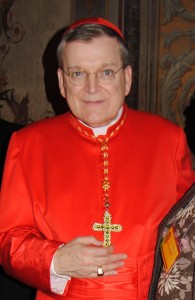 On November 8, the Holy Father Francis received in audience participants in the Plenary Assembly of the Supreme Tribunal of the Apostolic Signature with the Prefect, Raymond Leo Cardinal Burke (he’s one of our American Prelates in service to the Holy Father at the Curia). A plenary session allows for the consulters and those assigned to a particular office to meet to discuss business but also to meet with the Pope so as to hear what he has to say on a particular theme of his choosing. A plenary session is held once a year.
On November 8, the Holy Father Francis received in audience participants in the Plenary Assembly of the Supreme Tribunal of the Apostolic Signature with the Prefect, Raymond Leo Cardinal Burke (he’s one of our American Prelates in service to the Holy Father at the Curia). A plenary session allows for the consulters and those assigned to a particular office to meet to discuss business but also to meet with the Pope so as to hear what he has to say on a particular theme of his choosing. A plenary session is held once a year.
The Wisconsin native, Raymond Leo Cardinal Burke is a brilliant noteworthy churchman. His Eminence earned his doctorate in Canon Law from the Gregorian University in 1984. John Paul named Burke to be the Defender of the Bond of the same tribunal he now leads. He was previously the bishop of La Crosse and archbishop of St Louis. Pope Benedict appointed him to the present work in 2008 and a cardinal in 2010.
Supreme Tribunal of the Apostolic Signature, one of three ecclesiastical tribunals of the Holy See, is the highest judicial authority of the Church; the Prefect, acting in the name of the Pope, is the minister of justice. The decree of justice is sent under a signature, hence, “signature,” administering the justice asked for by the people of God. There are 25 prelates who assist the Prefect and his staff. You can learn more about the ministry of the Apostolic Signature by reading the articles in Pastor Bonus.
Here, the Pope focuses on truth and justice in the work of the Defender of the Bond with regard to the sacrament of Marriage. The Defender of the Bond and the judge of martial cases work together to ascertain the truth and are not in competition with each other but is the point of communion between what is revealed in scripture, lived in the sacraments and lived in the world. You can see to what extent Mother Church tries to care for her married children in a time of hurt and discouragement.
The following his Francis’ talk with my emphasis.
This, your Plenary Session, gives me the opportunity to receive all of you who work in the Supreme Tribunal of the Apostolic Signature, expressing to each one my gratitude for the promotion of the correct administration of justice in the Church. I greet you cordially and I thank the Cardinal Prefect for the words with which he introduced our meeting.
Your activity is geared to fostering the work of the ecclesiastical tribunals, called to respond adequately to the faithful who turn to the justice of the Church to obtain a correct decision. You do your utmost so that they function well, and you support the responsibility of bishops in forming suitable ministers of justice. Among these, the Defender of the Bond carries out an important function, especially in the process of matrimonial nullity. It is necessary, in fact, that he be able to fulfill his own part with efficacy, to facilitate the attainment of truth in the definitive sentence, in favor of the pastoral good of the parties in question.
In this regard, the Apostolic Signature has offered significant contributions. I am thinking in particular of the collaboration in the preparation of the Instruction Dignitas connubii, which explains the applicable trial norms. Placed in this line also is the present Plenary Session, which has put at the center of its works the promotion of an effective defense of the matrimonial bond in the canonical processes of nullity.
The attention given to the ministry of the Defender of the Bond is without a doubt opportune, because his presence and his intervention are obligatory for the whole development of the process (cf. Dignitas connubii, 56, 1-2; 279, 1). Foreseen in the same way is that he must propose all sorts of proofs, exceptions, recourses and appeals that, in respect of the truth, foster the defense of the bond.
The mentioned Instruction describes, in particular, the role of the Defender of the Bond in the causes of nullity for psychic incapacity, which in some Tribunals constitute the sole reason for nullity. It underlines the diligence that he must put in assessing the questions addressed to the experts, as well as the results of the opinions themselves (cf. 56, 4). Therefore, the Defender of the Bond who wishes to render a good service cannot limit himself to a hasty reading of the acts, or to bureaucratic and generic answers. In his delicate task, he is called to try to harmonize the prescriptions of the Code of Canon Law with the concrete situations of the Church and of society.
The faithful and complete fulfillment of the task of the Defender of the Bond does not constitute a pretension damaging of the prerogatives of the ecclesiastical judge, to whom corresponds solely the definition of the cause. When the Defender of the Bond exercises the duty to appeal, also to the Roman Rota, against a decision which he holds damaging to the truth of the bond, his task does not abuse that of the judge. In fact, the judges can find, in the careful work of him who defends the matrimonial bond, a help to their own activity.
The Second Ecumenical Vatican Council defined the Church as communion. Seen in this perspective are the service of the Defender of the Bond and the consideration that is reserved to him, in a respectful and attentive dialogue.
A final, very important annotation as regards the workers committed in the ministry of ecclesial justice. They act in the name of the Church; they are part of the Church. Therefore, it is necessary to always keep alive the connection between the action of the Church that evangelizes and the action of the Church that administers justice. The service to justice is a commitment of apostolic life: it requires to be exercised by keeping one’s gaze fixed on the icon of the Good Shepherd, who bends down to the lost and wounded sheep.
At the conclusion of this meeting, I encourage you all to persevere in the search for a limpid and correct exercise of justice in the Church, in response to the legitimate desires that the faithful address to Pastors, especially when, confidently, they ask to have their own status authoritatively clarified. May Mary Most Holy, who we invoke with the title Speculum iustitiae, help you and the whole Church to walk on the path of justice, which is the first form of charity. Thank you and good work!
Saint Rose Philippine Duchesne and the basilicas
 Today we have two feasts that may not immediately be perceived as connected: the Dedication of the Basilicas of Saint Peter and Saint Paul and the liturgical memorial of Saint Rose Philippine Duchesne (1769-1852), who had the desire to live a life of contemplation.
Today we have two feasts that may not immediately be perceived as connected: the Dedication of the Basilicas of Saint Peter and Saint Paul and the liturgical memorial of Saint Rose Philippine Duchesne (1769-1852), who had the desire to live a life of contemplation.
To make a little sense of what we have today let’s step back nearly ten days ago to the liturgical memorial of the Dedication of Lateran Basilica. On that feast we noted that the church was dedicated to Saint John the Baptist and it recalls for us the ministry of the bishop of Rome to lead, teach and sanctify. Key in that feast is not the praise of architecture but what John the Baptist said: I must decrease and He [Jesus] must increase. If we forget these words then we’re lost. The petition in the Prayer after Communion asked God to use the earthly sign of the Church as an instrument of sacramentality that would transform us into a new temple bestowing a new humanity upon for the purpose of being in glory with the Trinity.
With the liturgical memorial of the two basilicas of Peter and Paul —another liturgical day on which we do not merely honor bricks and mortar— we have another aspect of the Christian life being brought forward: having knowledge of divine things which lead to a life of grace. The feast, therefore, is a reminder that our faith has a genealogy —it is rooted in the apostolic witness of Peter and Paul. We follow an experience; we are lead to Jesus by those who knew Him.
The anniversary of the dedication of the two basilicas keeps our hearts on the source of our Christian life: the proclamation of the Word and the consumption of the Eucharistic Sacrifice for our eventual life in heaven but also to do what Jesus did. What the Apostles did for us so long ago continues to happen today. From the dual altars of the ambo and altar we are nourished and in turn we are sent out, like Peter and Paul, to cooperate with the action of the Holy Spirit.
Pope Leo the Great on the Memorial of the Dedication of the Basilicas of Saint Peter and Saint Paul once said:
“From this field [the Church] those two famous shoots of the divine seed burst forth into a great progeny, witnessed by thousands of blessed martyrs. To emulate the apostles’ triumph, these martyrs have adorned our city far and wide with people clothed in purple and shining brilliantly, and they have crowned it with a diadem fashioned by the glory of many precious stones….
Our experience has shown, as our predecessors have proved, that we may believe and hope that in all the labors of the present life, by the mercy of God, we shall always be helped by the prayers of our special patrons. Just as we are humbled by our own sins, so we shall be raised up by the merits of these apostles.”
Where does Saint Rose Philippine fit? This wise virgin who, while waiting for Jesus lit the lamp by a life of charity and missionary zeal making her Bridegroom known to a world unfamiliar with His word of Life. She was a light in darkness.
Remember, Saint Rose is an American saint buried in Saint Charles, Missouri. She is known for her devotion to the Blessed Sacrament, an intense prayer life, and being a missionary. If you are listening to the talks being given in Mexico these days by the bishops and the Pope (via satellite) being a person of prayer and being missionary is the existential vocation of the Church as she is living and proposing what has been left to us by Jesus.
Hence, our Christian lives in the American context is framed by the Baptist’s exhortation to mature in the Paschal Mystery all the while being formed by the Cross and following the Jesus, and living what’s been given: mercy in the world in which we find ourselves AND by the missionary zeal of an American nun.
Oratorians of Brooklyn
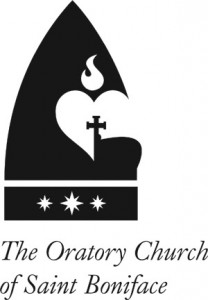 Saint Philip Neri and his ability to connect with the common person is seen in the ministry of his sons at the Oratory of Saint Boniface in Brooklyn, NY. Saint Philip’s charism is alive and bringing Jesus the people and people to Jesus.
Saint Philip Neri and his ability to connect with the common person is seen in the ministry of his sons at the Oratory of Saint Boniface in Brooklyn, NY. Saint Philip’s charism is alive and bringing Jesus the people and people to Jesus.
The Oratorians took a dead parish community and by cooperating with Grace revitalized the parish making it a place of prayer now called the The Oratory Church of Saint Boniface. They’ve renovated their church, provide an excellent sacred music ministry, an intellectual outreach as well as a myriad of ways of responding to the needs of those in need.
In a real way these urban and contemporary religious men are making being Catholic interesting, and dare I say, captivating, by making what the 16th century layman-turn-priest and saint said and did. very concrete. The Oratorian priests and brothers are a different type of religious congregation say from the Benedictines, Jesuits and Dominicans. The men live permanently in one place, take no religious vows yet they promise to live in charity with each other serving in whatever need is identified: parish work, spiritual ministries, work with the poor and marginalized, teaching catechism and the like. The Provost is the religious superior of the local group –the point of unity– and the diocesan bishop gives the priestly faculties. Mutual obedience, concern for one another and joy are hallmarks of the Oratorian life. Each Oratorian is respected for his relationship with the Lord and the gift of self to the Church. Neri was an evangelizer, and so are his sons.
NET TV –a media ministry of the Brooklyn Diocese– interviewed the Fathers and Brothers of the Oratory recently giving an insight into their life and work among the people of God.
Visit The Brooklyn Oratory.
Saint John Chrysostom
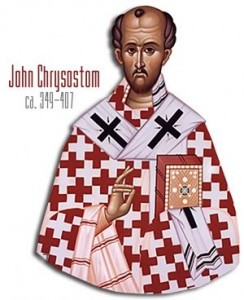 On the Byzantine liturgical calendar, today is the feast of John, patriarch of Constantinople, called “Chrysostom” (which is Greek for “the golden-tongued,” in reference to his amazing gift for preaching the Word of God).
On the Byzantine liturgical calendar, today is the feast of John, patriarch of Constantinople, called “Chrysostom” (which is Greek for “the golden-tongued,” in reference to his amazing gift for preaching the Word of God).
The Latin Church observes the liturgical memorial of Saint John Chrysostom on 14 September. He is revered as our holy father and for that reason he bears mention again. One of the Divine Liturgies of the Byzantine Church, the one used most days, is ascribed to him.
It is hard to overstate the importance of Saint John Chrysostom for Christians due to the intensity of his person, the force of his preaching and the reasonableness of his teaching.
The “Cherubic Hymn,” a chant, is taken his Divine Liturgy, is sung at the time of the Great Entrance. (For Latin Catholics, the Cherubic Hymn is a hymn sung at the presentation of the gifts, a text which is fixed for all but a few days of the liturgical year).
The Cherubic hymn ought to form part of our daily prayer.
We who mystically represent the Cherubim,
and who sing to the Life-Giving Trinity the thrice-holy hymn,
let us now lay aside all earthly cares
that we may receive the King of all,
escorted invisibly by the angelic orders. Alleluia
Relics of St Peter, Apostle and First Pope, to be exposed
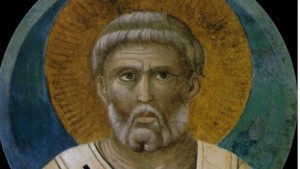 The relics of St. Peter, Apostle and the First Pope, will be exposed in Rome for the conclusion of the Year of the Faith.
The relics of St. Peter, Apostle and the First Pope, will be exposed in Rome for the conclusion of the Year of the Faith.
Archbishop Rino Fisichella, head of the Council for the New Evangelization, announced that in anticipation of the close of the Year of Faith on the Solemnity of Christ the King 2013, the relics of the first Bishop of Rome will be exposed.
“A final culminating sign will consist in the exposition for the first time of the relics that tradition recognizes as those of the apostle that gave his life for the Lord,” stated L’Osservatore Romano, the Vatican newspaper (Nov 8, 2013).
Pope Benedict XVI instituted the Year of Faith, running from October 11, 2012 until November 24, 2013.
Exposing the remains of St. Peter will be a unique “epilogue” to the Year of Faith, insisted Archbishop Fisichella, because it “has been marked in particular by the profession of faith that millions of pilgrims have made to the tomb of Peter.”
“It will be a moment of grace and commitment to a more complete conversion to God, to strengthen our faith in Him and proclaim Him with joy to the people of our time,” the retired pontiff stated in the Fall of 2011 upon the announcement of the event.
Here is an interesting guide of St Peter’s tomb.
Pope Francis meets Orthodox Metropolitan Hilarion
The meeting of Pope Francis with Metropolitan Hilarion –the not first– ran concurrent today with Cardinal Angelo Scola of Milan meeting in Moscow with Patriarch Kirill, leader of the Russian Orthodox Church. Francis like Benedict, and with Hilarion and Kirill there is a substantial commitment to good fraternal relations with various members of the Orthodox Church which is really fantastic.
Vatican Radio’s Philippa Hitchen spoke with one of the editors of the journal, Irenikon, Benedictine Father Thaddeus Barnas of Chevetogne Abbey, whose founding by the famed Dom Lambert Beauduin following the 1924 encourage of Pope Pius XI which focussed on the Orthodox spirituality and promoting reconciliation between Catholics and Orthodox. The Benedictines monks seek the face of God, and they work for ecumenical connections from the standpoint of prayer, study and fraternal relations. Listen to the interview with Father Thaddeus.
